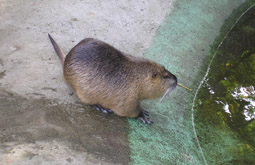Nutria on farms
On some farms, nutria are kept in concrete bunkers that are 2 x 6 - 8 m, which corresponds to a ground surface of 12 - 16 m². Such housing usually comprises 4 shelter possibilities as well as a bathing installation with running water. As a rule, 5 – 8 females and one male animal are kept together in such a concrete bunker. These bunkers are too small in size to meet the animals’ requirements. They are only approx. 3 - 6% of the animal’s natural territory. Nutria instinctively dig holes and caves in the earth. The concrete floor of the bunker makes this impossible. Although the bunkers are equipped with bathing possibilities, they are by far too small for the animals. Often, all they are able to do is cool off; proper swimming in line with their natural habits is impossible. Insufficient care and cleaning of the concrete bunkers often leads to a rapid spread of contagious diseases, so that often enough, a large number of nutria perish in only a very short time.
In other farms, nutria are kept in standard cages, like fox and mink. This is primarily the case in countries with no or inadequate laws on animal keeping. Such keeping methods are far from being species-appropriate, in particular if the nutria are not given access to water. Moreover, the cages have mesh wire floors and are not structured. The mesh wire floors lead to injuries and deformations to the animals’ paws. As with all animals, such a monotonous environment, without the possibility to behave according to their nature, leads to behavioral disturbances.
On animal fur farms, nutria are regularly removed from their cages for breeding, for their fur to be measured, for medicating, or for cages to be switched. This causes the animals tremendous stress and makes them panic. The young are slaughtered at 7 or 8 months, usually precisely when the females are already pregnant.
Concrete or mesh floors

A concrete bunker on a fur farm
Additional information
-
The «Humane Society of the United States» and its Fur free campaign
The Canadian environmental protection organization «Global Action Network» and its extensive anti-fur campaign.
